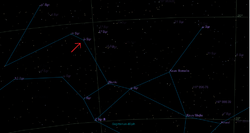Omicron Sagittarii
ο Sagittarii, Latinized as Omicron Sagittarii, is a single[9] star in the constellation Sagittarius. It is yellow in hue and visible to the naked eye with an apparent visual magnitude of +3.77.[2] The distance to this star is approximately 142 light years based on parallax.[1] It is drifting further away from the Sun with a radial velocity of +26 km/s, having come to within 86 ly around a million years ago.[5]
| Observation data Epoch J2000.0 Equinox J2000.0 | |
|---|---|
| Constellation | Sagittarius |
| Right ascension | 19h 04m 40.98177s[1] |
| Declination | −21° 44′ 29.3845″[1] |
| Apparent magnitude (V) | +3.771[2] |
| Characteristics | |
| Evolutionary stage | horizontal branch[3] |
| Spectral type | G9IIIb[4] |
| B−V color index | +1.012±0.008[5] |
| Astrometry | |
| Radial velocity (Rv) | +26.1±0.6[5] km/s |
| Proper motion (μ) | RA: +76.35±0.31[1] mas/yr Dec.: −58.12±0.18[1] mas/yr |
| Parallax (π) | 22.96 ± 0.24[1] mas |
| Distance | 142 ± 1 ly (43.6 ± 0.5 pc) |
| Absolute magnitude (MV) | 0.625[2] |
| Details | |
| Mass | 1.80[6] M☉ |
| Radius | 12.09+0.29 −0.17[7] R☉ |
| Luminosity | 66.7±1.1[7] L☉ |
| Surface gravity (log g) | 2.66[2] cgs |
| Temperature | 4,744+34 −57 K |
| Metallicity [Fe/H] | −0.04[2] dex |
| Age | 2.39[6] Gyr |
| Other designations | |
| Database references | |
| SIMBAD | data |
This object is position 0.86 degrees north of the ecliptic, so ο Sagittarii can be occulted by the Moon and very rarely by planets. The last occultation by a planet took place on 24 December 1937, when it was occulted by Mercury. It was almost eclipsed by the sun, which occupies a mean, rounded, half of one degree of the sky, on 5 January.[10] Thus the star can be viewed the whole night, crossing the sky, in early July.
This is an aging giant star with a stellar classification of G9IIIb.[4] It is classified as a red clump giant, suggesting it is on the horizontal branch undergoing core helium fusion.[3] The star is 2.39[6] billion years old with 1.80[6] times the mass of the Sun. It has expanded to 12 times the girth of the Sun and is radiating 67 times the Sun's luminosity from its swollen photosphere at an effective temperature of 4,744 K.[7]
It has a faint, magnitude 13.8 companion, designated component B and positioned 38.4″ away along a position angle of 252°, as of 2010.[11]
Name and etymology
- In Chinese, 建 (Jiàn), meaning Establishment, refers to an asterism consisting of ο Sagittarii ξ² Sagittarii, π Sagittarii, 43 Sagittarii, ρ¹ Sagittarii and υ Sagittarii. Consequently,the Chinese name for ο Sagittarii itself is 建二 (Jiàn èr, English: the Second Star of Establishment.)[12]
References
- van Leeuwen, F. (2007), "Validation of the new Hipparcos reduction", Astronomy and Astrophysics, 474 (2): 653–664, arXiv:0708.1752, Bibcode:2007A&A...474..653V, doi:10.1051/0004-6361:20078357.
- Liu, Y. J.; et al. (2007), "The abundances of nearby red clump giants", Monthly Notices of the Royal Astronomical Society, 382 (2): 553–66, Bibcode:2007MNRAS.382..553L, doi:10.1111/j.1365-2966.2007.11852.x.
- Alves, David R. (August 2000), "K-Band Calibration of the Red Clump Luminosity", The Astrophysical Journal, 539 (2): 732–741, arXiv:astro-ph/0003329, Bibcode:2000ApJ...539..732A, doi:10.1086/309278.
- Keenan, Philip C.; McNeil, Raymond C. (1989), "The Perkins Catalog of Revised MK Types for the Cooler Stars", The Astrophysical Journal Supplement Series, 71: 245, Bibcode:1989ApJS...71..245K, doi:10.1086/191373.
- Anderson, E.; Francis, Ch. (2012), "XHIP: An extended hipparcos compilation", Astronomy Letters, 38 (5): 331, arXiv:1108.4971, Bibcode:2012AstL...38..331A, doi:10.1134/S1063773712050015.
- Luck, R. Earle (2015), "Abundances in the Local Region. I. G and K Giants", The Astronomical Journal, 150 (3): 88, arXiv:1507.01466, Bibcode:2015AJ....150...88L, doi:10.1088/0004-6256/150/3/88.
- Brown, A. G. A.; et al. (Gaia collaboration) (August 2018). "Gaia Data Release 2: Summary of the contents and survey properties". Astronomy & Astrophysics. 616. A1. arXiv:1804.09365. Bibcode:2018A&A...616A...1G. doi:10.1051/0004-6361/201833051. Gaia DR2 record for this source at VizieR.
- "omi Sgr". SIMBAD. Centre de données astronomiques de Strasbourg. Retrieved 2019-10-09.
- Eggleton, P. P.; Tokovinin, A. A. (September 2008), "A catalogue of multiplicity among bright stellar systems", Monthly Notices of the Royal Astronomical Society, 389 (2): 869–879, arXiv:0806.2878, Bibcode:2008MNRAS.389..869E, doi:10.1111/j.1365-2966.2008.13596.x.
- In the Sky Earth astronomy reference utility showing the ecliptic and relevant date as at J2000 - present
- Mason, Brian D.; et al. (2001), "The 2001 US Naval Observatory Double Star CD-ROM. I. The Washington Double Star Catalog", The Astronomical Journal, 122 (6): 3466, Bibcode:2001AJ....122.3466M, doi:10.1086/323920.
- (in Chinese) AEEA (Activities of Exhibition and Education in Astronomy) 天文教育資訊網 2006 年 5 月 11 日
